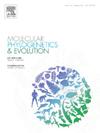利用系统发育数据进行岛屿生物地理分析:DAISIEprep软件包。
IF 3.6
1区 生物学
Q2 BIOCHEMISTRY & MOLECULAR BIOLOGY
引用次数: 0
摘要
从分子系统发育中推断过去的进化、生态和生物地理过程的新方法正在迅速发展。然而,它们通常使用不熟悉的数据结构,这可能会对它们的使用造成障碍。DAISIE(通过物种形成、移民和灭绝的岛屿动态组合)是一个岛屿生物地理学模型,可以根据岛屿组合的分子系统发育数据估计定植、物种形成和灭绝的速率。该方法使用了一种非常规的系统发育数据结构:它不是考虑单个岛屿谱系,而是关注来自岛屿不同殖民化事件的多个独立谱系。虽然从这个角度分析系统发育有很大的潜力,但这也给用户带来了挑战。在这里,我们描述了DAISIEprep软件,这是一个R软件包,用于帮助从一个或多个系统发育树中提取数据,以宏观进化和生物地理推理模型可解释的格式生成和可视化数据。DAISIEprep包括简单的算法来提取岛屿殖民者的数据,并解释生物地理学、拓扑学和分类学的不确定性。当分子数据无法获得时,它还允许灵活地合并缺失的物种或整个岛屿谱系。该软件能够对来自岛屿谱系的系统发育数据进行可重复和用户友好的数据提取、格式化和可视化,并将有助于解决有关岛屿进化、群落生态学和岛屿系统中人为影响的问题。对于不打算使用DAISIE但对如何解释、可视化和分析岛屿物种或类岛环境的系统发育数据集感兴趣的研究人员来说,这里提供的工具也很有用。本文章由计算机程序翻译,如有差异,请以英文原文为准。

Using phylogenetic data for island biogeography analyses: The DAISIEprep package
New methodologies to infer past evolutionary, ecological and biogeographical processes from molecular phylogenies are rapidly being developed. However, these often employ unfamiliar data structures that may pose a barrier to their use. DAISIE (Dynamic Assembly of Islands through Speciation, Immigration and Extinction) is an island biogeography model that can estimate rates of colonisation, speciation and extinction from molecular phylogenetic data across insular assemblages. The method uses an unconventional phylogenetic data structure: instead of considering a single island lineage, it focuses on multiple independent lineages descending from different colonisation events of the island. While analysing phylogenies from this perspective has plenty of potential, this comes with challenges for the user. Here we describe software DAISIEprep, an R package to aid the extraction of data from one or many phylogenetic trees to generate and visualise data in a format interpretable by macroevolutionary and biogeographical inference models. DAISIEprep includes simple algorithms to extract data on island colonists and account for biogeographical, topological and taxonomic uncertainty. It also allows flexible incorporation of either missing species or entire insular lineages when molecular data are not available. The software enables reproducible and user-friendly data extraction, formatting and visualisation of phylogenetic data from island lineages, and will facilitate addressing questions about island evolution, community ecology and anthropogenic impacts in insular systems. The tools presented here will also be useful for researchers who do not plan to use DAISIE but are interested in how to interpret, visualise and analyse phylogenetic datasets of islands species or island-like environments.
求助全文
通过发布文献求助,成功后即可免费获取论文全文。
去求助
来源期刊
CiteScore
7.50
自引率
7.30%
发文量
249
审稿时长
7.5 months
期刊介绍:
Molecular Phylogenetics and Evolution is dedicated to bringing Darwin''s dream within grasp - to "have fairly true genealogical trees of each great kingdom of Nature." The journal provides a forum for molecular studies that advance our understanding of phylogeny and evolution, further the development of phylogenetically more accurate taxonomic classifications, and ultimately bring a unified classification for all the ramifying lines of life. Phylogeographic studies will be considered for publication if they offer EXCEPTIONAL theoretical or empirical advances.

 求助内容:
求助内容: 应助结果提醒方式:
应助结果提醒方式:


